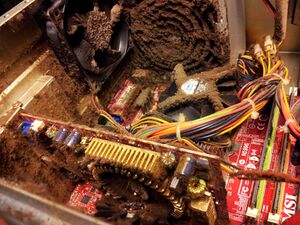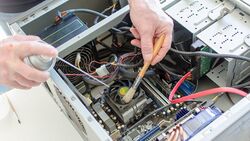Computer maintenance
Computer maintenance is the practice of keeping computers in a good state of repair. A computer containing accumulated dust and debris may not run properly.
PC Components
Keyboard
The crumbs, dust, and other particulate that fall between the keys and build up underneath are loosened by spraying pressurized air into the keyboard, then removed with a low-pressure vacuum cleaner. A plastic-cleaning agent applied to the surface of the keys with a cloth is used to remove the accumulation of oil and dirt from repeated contact with a user's fingertips. If this is not sufficient for a more severely dirty keyboard, keys are physically removed for more focused individual cleaning, or for better access to the area beneath. Finally, the surface is wiped with a disinfectant.
Monitor
A monitor displays information in visual form, using text and graphics. The portion of the monitor that displays the information is called the screen. Like a television screen, a computer screen can show still or moving pictures and It's a part of Output Devices.
Mouse
The top surface of the mouse is wiped with a plastic cleanser to remove the dirt that accumulates from contact with the hand, as on the keyboard. The bottom surface is also cleaned to ensure that it can slide freely. If it is a mechanical mouse, the trackball is taken out, not only to clean the ball itself, but to scrape dirt from the runners that sense the ball's movement and can become jittery or stuck if impeded by grime.
Tower/desktop unit
Internal components accumulate dust brought in by the airflow maintained by fans to keep the PC from overheating. A soft brush may remove loose dirt; the remainder is dislodged with compressed air and removed with a low-pressure vacuum. The case is wiped down with a cleaning agent. A pressurized blower or gas duster can remove dust that cannot be reached with a brush.[1]
Data
Backups
Important data stored on computers may be copied and archived securely so that, in the event of failure, the data and systems may be reconstructed. When major maintenance such as patching is performed, a backup is recommended as the first step in case the update fails and reversion is required.
Disk cleanup may be performed as regular maintenance to remove these. Files may become fragmented and so slow the performance of the computer. Disk defragmentation may be performed to combine these fragments and so improve performance.
Legal issues
In the US, the Digital Millennium Copyright Act specifically exempts computer-maintenance activities, so copies of copyright files may be made in the course of maintenance provided that they are destroyed afterwards.[2]
Software
Operating system
Operating-system files such as the Windows registry may require maintenance. A utility such as a registry cleaner may be used for this. Also inbuilt Disk defragmenter will also help.
Software updates
Softwares packages and operating systems may require regular updates to correct software bugs and to address security weaknesses.
Software updates in computer maintenance[3] are essential for maintaining the functionality and efficiency of systems. These updates often include enhancements that improve the overall performance and stability of software and operating systems. They also introduce new features and capabilities, ensuring that the software remains compatible with evolving technological standards and user needs. Regularly updating software is a key practice in keeping computer systems up-to-date and running smoothly.
Security
Maintaining security involves vulnerability management and installation and proper operation of antivirus software like Kaspersky, Avast Antivirus, McAfee and Many are available.
References
- ↑ Acosta, Jeremy. "Basic Computer Maintenance". http://gamesngearselite.com/computer-basic-maintenance/.
- ↑ Kent D. Stuckey (1996), Internet and online law, pp. 6–47
- ↑ Marcin, Wieclaw (11 January 2023). "Software Updates as an Important Part of PC Maintenance". https://pcsite.co.uk/software-updates/.
 |



